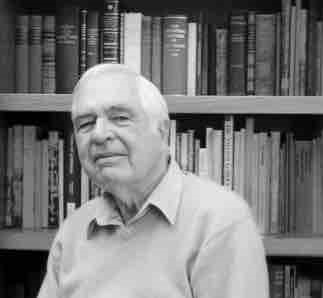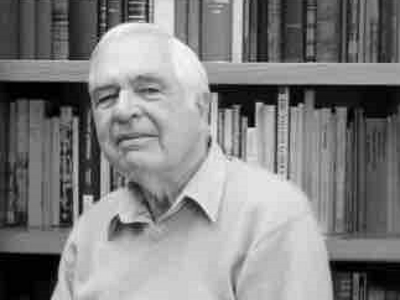Interview Recording
Interview Transcript
Professor Richard Clough AM interviewed on 9 December 2003 by Roslyn Burge
Synopsis
Richard Clough was born in 1921 in Wagga Wagga where his family had been since the 1850s. He described early influences…
My mother’s father’s family came from Germany … In country towns (then)… people as a side-line sold plants … wreaths … wedding bouquets… My great-grandmother… imported bulbs from Holland … selling the plants… So, she was a very good gardener and … my grandfather … and my mother …
Clough studied architecture at Sydney University (SU) in 1939 and this was interrupted for two years by war. Then students who had done the larger part of their courses were allowed back to finish. After graduation he worked for SU in 1947 and then Fowell Mansfield 1948-9. It was accepted at that time for students to complete their education abroad and particularly England. At first he worked at Westwood Sons & Harrison, then for Sir Henry Tanner. Later he went on to study Landscape Design. This decisive step was influenced through having gone to university with Ian Waterhouse and getting to know his family…
Professor (EG) Waterhouse (Ian’s father) had been in charge of the landscape at Sydney University for years … as well as being famous for the creation of his own garden…(Eryldene, Gordon) and he tried to get Sydney University to establish a course in landscape architecture without success and constantly urged people to take up the study of it.
In 1950 the Royal Horticultural Society in London organised the Camellia and Magnolia Conference and Professor and Mrs Waterhouse came … I had afternoon tea with them and (the) Professor … was telling me that he’d had lunch with Lanning Roper … and they’d talked about landscape design. He said, ‘That’s what you should be studying …’ I made enquires and found … a new course starting at University College London…
I was the first Australian I think to study Landscape Architecture at a tertiary organisation outside Australia… the course … was run by a Cambridge graduate, Peter Youngman, who had a horticultural background… (He) was … very inspiring …and …knew lots of people including …Vita Sackville-West …(who) he organised for us to meet … The … profession …was very small so I was able to go and visit … landscape architects in Italy (Professor Porcinai and so on), Sweden … Norway … Spain … Germany and Denmark…
Clough had done the course because he was interested …
It wasn’t with any professional intent … However, the secretary of the institute, Mrs Brown, knew … that I’d completed … entry into… the British Institute of Landscape Architects; and … said …, ‘Oh, Sylvia Crowe is looking for someone to work at Basildon, why don’t you go and see her?’ … so I went … and she asked … if I’d be prepared to go and work on … the last of the first range of British new towns … in Essex …(for whom she) was … consultant … She came … every Thursday … gave me tasks … and … looked at what I had done … Miss Crowe’s influence on me was much more important than anybody else’s …It was her approach. She was the most intellectually stimulating person … and …I have never worked for anyone … whose work was so based on well thought through principles that she never changed her mind.
The project … was fascinating… it was … in a … degraded rural landscape, very heavy clay … in the middle of the nineteenth century it had gone out of … production because the wheat and so on started coming from America and Australia…it was sufficiently close to the West End of London for the land to be sold off in blocks for five pounds a piece.
… the whole area was sub-divided … and …during the war when people were bombed out of the East End … – they might have had a shack … or a tent … moved down … and … lived there…and … used their lands differently. Some grew vegetables … some did nothing … It was … ecologically fascinating … there was every stage of natural regeneration from agricultural land to oak forest and to take this … and use what was there … that’s the great thing about Miss Crowe’s …(approach).
In 1956 Clough returned to Australia and worked for the National Capital Development Commission (NCDC) from 1959. Did he incorporate some of his learnings?
I …certainly tried to… it’s always been my intention to follow that principle, to see landscape; especially … in Canberra, as a means of unifying the total area… of hiding unpleasant and distasteful developments … and I’ve been most satisfied (with work)… when nobody realises …that anything has happened…
I was … Landscape Architect for Macquarie University from the beginning and it was … similarly degraded… It had been divided up into small holdings, chicken farms…vegetable plots …cut flowers… and some … just left waste… I think that people who go … these days are unaware of the (site’s) past history… they see it now as something … integrated … which relates to its surroundings. I hope that in all my work… I take note of the surroundings as much as of the work that goes on within the site itself.
Clough worked on various university campuses at the same time…
In those days there weren’t too many landscape architects around and the Commission gave me permission to work on a selected number of outside projects … in my own time… I worked with Professor (Lindsay) Pryor on the Flinders … and Latrobe Universities. And … with Mr Lane Poole on the new Kings School … in Sydney.
Occasionally he worked with friends on private gardens. …
I’d begun working with the Valders … (Nooroo) at Mount Wilson… and I continued to advise them … And occasionally I would do a garden for a friend in Canberra. But … I’d much rather work on a factory or a sewerage treatment works …because … you are doing … work which will benefit society rather than an individual.
Richard became Professor of Landscape Architecture at UNSW in 1981. He loved teaching and giving something back…
I found … there was a big influx of students from South-East Asia and the course was very western-oriented … There was nothing … that related to their cultures and so I taught Eastern Architecture to … architecture students and … Oriental Landscape History to … landscape students. And encouraged them to take up Australian history for their theses.
Richard has derived tremendous pleasure from being a collector most of his life, whether books or garden visits …and nursery catalogues…
I decided once I retired to do certain things which I hadn’t done when I was working … I thought nobody has studied to any great extent the rise and fall in popularity of particular flowers and… one way of quantifying that would be to look to see when new varieties … came on to the market… I thought you could quantify … (popularity) by looking to see how many new varieties were offered … The only way I thought of doing this was to make a fairly thorough search through old catalogues… By going to public libraries … I found that, there wasn’t such a great collection … available so I decided to concentrate… on acquiring a number … His collection has now been given to the State Library of NSW.
In terms of his contribution to Australian garden history Richard has contributed to the Oxford Companion (2002), worked with Colleen Morris and Victor Crittenden. What is his interest?
… my support for the … Society is … firstly, because it publishes … a very good journal and the only one which enables people to set out … material … that they’ve done research on. And secondly… the Society has encouraged people to look at gardens from a historic point of view. I think that the … journal… (as it is) is the right sort of work for Australia at this particular point in time.
Since the Garden History Society started … or its first conference in 1980, how do you think the study of garden history has continued and developed?
Well … in various ways. I mean there are a few academics who rely on …publications … to get promotion and … write not because they are particularly interested in the subject …, not because the subject is important … but simply to gain financial advantage … some of the (published) material … I think is of questionable value.
But the whole idea of garden history is spread … not only by the Society… you come across libraries in various country towns or suburbs where a particular historic garden history material is featured, so there’s a widespread interest …Happily it’s not just political … or economic history … I think that all aspects of cultural history are gaining… in our society.
You were just talking about garden history…
Yes, well garden history is about gardening, certainly, as well as about gardens. I think while the study of gardens is important it’s also fascinating to study gardening. The changes in fashions … why those … occurred and to try and understand the gardens of the past and … that we can’t actually retain them as they were. Gardens, unlike architecture, are constantly changing. … there are a certain limited number of gardens that can be retained exactly as they were designed but in almost all cases gardens depend very much on the gardener. The …person who created them … shaped the plants… combined the colours… did the weeding … made the changes. And people’s interest … wasn’t in establishing a single unity that’s unchanging, their interest … was in change and if we stop change then we stop the real essence of a lot of gardens… We’ve got to accept change … to realise that garden history isn’t about preservation solely in the sense of keeping them as documents.
There we are, that is a sort of heresy to end up with!



